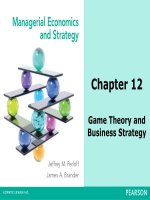Managerial economics 3rd by froeb ch01
Bạn đang xem bản rút gọn của tài liệu. Xem và tải ngay bản đầy đủ của tài liệu tại đây (648.3 KB, 6 trang )
11
Introduction:
What This Book
is About
1
Copyright ©2014 Cengage Learning. All Rights Reserved. May not be scanned, copied or duplicated, or posted to a publicly accessible website, in whole or in part.
Summary of Main Points
▮ Problem solving requires two steps: First, figure out why
mistakes are being made; and then figure out how to
make them stop.
▮ The rational-actor paradigm assumes that people act
rationally, optimally, and self-interestedly. To change
behavior, you have to change incentives.
▮ Good incentives are created by rewarding good
performance.
▮ A well-designed organization is one in which employee
incentives are aligned with organizational goals. By this
we mean that employees have enough information to
make good decisions, and the incentive to do so.
Copyright ©2014 Cengage Learning. All Rights Reserved. May not be scanned, copied or duplicated, or posted to a publicly accessible website, in whole or in part.
2
Summary of Main Points (continued)
▮ You can analyze any problem by asking three questions:
1. Who is making the bad decision?;
2. Does the decision maker have enough information to
make a good decision?; and
3. the incentive to do so?
▮ Answers to these questions will suggest solutions
centered on
1. letting someone else make the decision, someone
with better information or incentives;
2. giving the decision maker more information; or
3. changing the decision maker’s incentives.
Copyright ©2014 Cengage Learning. All Rights Reserved. May not be scanned, copied or duplicated, or posted to a publicly accessible website, in whole or in part.
3
Problem: Over-bidding OVI gas tract
▮ A young geologist was preparing a bid
recommendation for an oil tract in the Gulf of
Mexico.
▮ With knowledge of the productivity of neighboring
tracts also owned by company, the geologist
recommended a bid of $5 million.
▮ Senior management, though, bid $20 million - far
over the next highest-bid of $750,000.
▮ What, if anything, is wrong?
▮ The goal of this text is to provide tools to help
diagnose and solve problems like this.
Copyright ©2014 Cengage Learning. All Rights Reserved. May not be scanned, copied or duplicated, or posted to a publicly accessible website, in whole or in part.
4
Problem solving
▮ Two distinct steps:
• Figure out what’s wrong, i.e., why the
bad decision was made
• Figure out how to fix it
▮ Both steps require a model of behavior
• Why are people making mistakes?
• What can we do to make them change?
▮ Economists use the rational actor paradigm to model
behavior. The rational actor paradigm states:
• People act rationally, optimally, self-interestedly
i.e., they respond to incentives – to change behavior you must
change incentives.
Copyright ©2014 Cengage Learning. All Rights Reserved. May not be scanned, copied or duplicated, or posted to a publicly accessible website, in whole or in part.
5
ANSWER:
Manager bonuses for increasing reserves
▮ The bonus system created incentives to over-bid.
• Senior managers were rewarded for acquiring reserves
regardless of their profitability
▮ Bonuses also created incentive to manipulate the
reserve estimate.
▮ Now that we know what is wrong, how do we fix it?
• Let someone else decide?
• Change information flow?
• Change incentives?
Performance evaluation metric
Reward scheme
Copyright ©2014 Cengage Learning. All Rights Reserved. May not be scanned, copied or duplicated, or posted to a publicly accessible website, in whole or in part.
6









